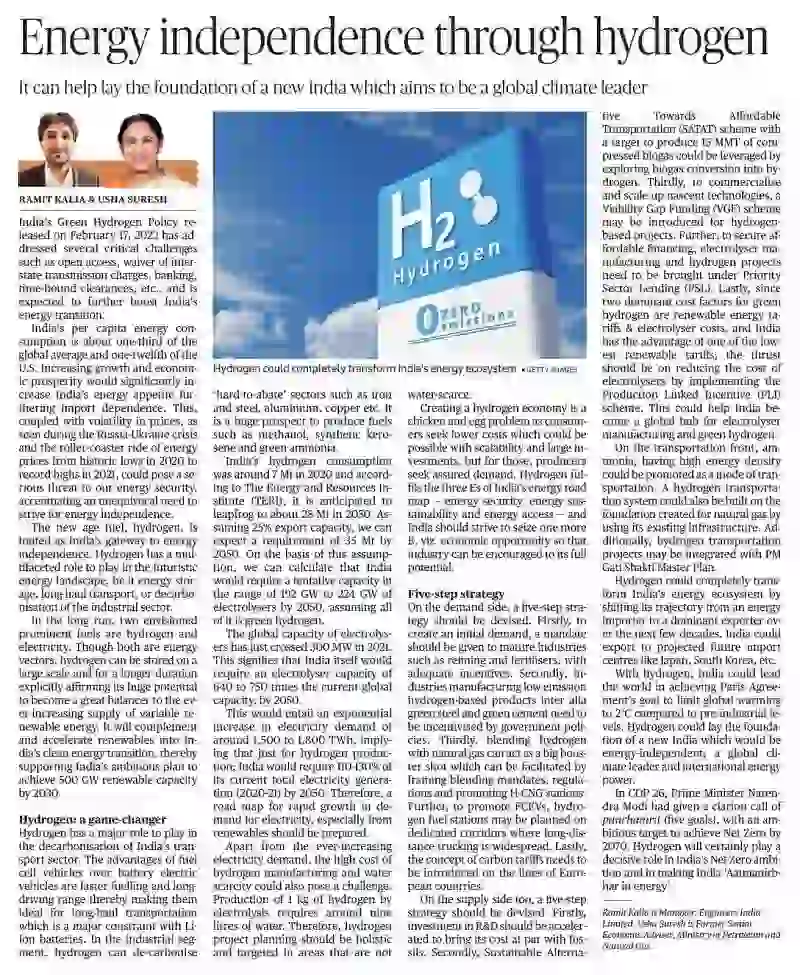Ramit Kalia Patent Energy Independence Through Hydrogen

1. Introduction
Energy independence has become a critical goal for nations worldwide, seeking to reduce reliance on foreign energy sources and improve energy security. One promising solution lies in hydrogen, an abundant and versatile energy carrier. This article explores how hydrogen, particularly through the innovations patented by Ramit Kalia, could revolutionize the energy landscape and pave the way for a more sustainable and independent energy future.
2. The Concept of Energy Independence
Definition and Importance
Energy independence refers to a nation’s ability to meet its energy needs without relying on imported resources. Achieving energy independence is crucial for economic stability, national security, and environmental sustainability. Countries with abundant local energy resources, such as renewables, are better positioned to control their energy costs and reduce their vulnerability to global market fluctuations.
Global Perspective on Energy Independence
Different countries pursue energy independence in various ways, depending on their natural resources and political landscapes. For example, the United States has made significant strides in energy independence through the development of shale oil and gas. Meanwhile, European nations are focusing on renewable energy sources like wind and solar. Hydrogen is emerging as a universal solution that can be integrated into existing energy systems worldwide.
3. Hydrogen as a Key Energy Source
Understanding Hydrogen as an Energy Carrier
Hydrogen is the most abundant element in the universe and serves as a clean energy carrier. Unlike traditional fossil fuels, hydrogen can be produced from various resources, including water, natural gas, and biomass. It can also be stored and transported, making it a flexible energy solution.
The Science Behind Hydrogen Energy
Hydrogen energy is generated through chemical reactions that produce electricity, heat, or mechanical power. One of the most common methods involves the use of fuel cells, which convert hydrogen and oxygen into water, generating electricity in the process. This reaction is highly efficient and produces no harmful emissions, making hydrogen a sustainable energy option.
4. Hydrogen Production Methods
Electrolysis
Electrolysis involves splitting water into hydrogen and oxygen using electricity. When powered by renewable energy sources, such as wind or solar, this method produces “green hydrogen,” a completely clean energy source.
Steam Methane Reforming
Steam Methane Reforming (SMR) is the most common method of hydrogen production today. It involves reacting methane with steam to produce hydrogen and carbon dioxide. While SMR is cost-effective, it relies on fossil fuels and emits CO2, making it less environmentally friendly.
Biomass Gasification
Biomass gasification converts organic materials, like wood and agricultural waste, into hydrogen. This method has the potential to be carbon-neutral, depending on the type of biomass used and the process’s efficiency.

5. Ramit Kalia’s Contributions
Background and Expertise of Ramit Kalia
Ramit Kalia is a renowned innovator and expert in hydrogen energy technology. With a background in chemical engineering and a passion for sustainable energy solutions, Kalia has made significant contributions to the field, particularly in hydrogen production and utilization.
Overview of Patents Filed by Ramit Kalia
Kalia has filed multiple patents related to hydrogen energy, focusing on improving production efficiency, reducing costs, and enhancing the scalability of hydrogen technologies. These patents have the potential to accelerate the adoption of hydrogen as a mainstream energy source.
6. The Impact of Ramit Kalia’s Patents on Hydrogen Energy
Innovations Introduced
Kalia’s patents introduce several key innovations, such as more efficient electrolysis techniques and advanced hydrogen storage solutions. These developments address some of the critical challenges in hydrogen production and distribution, making it more viable for widespread use.
Real-world Applications
The technologies patented by Kalia are already being tested and implemented in various industries, from transportation to manufacturing. These applications demonstrate the practical benefits of hydrogen energy and its potential to replace conventional fossil fuels in multiple sectors.
7. Case Study: Hydrogen in Transportation
Hydrogen Fuel Cells in Vehicles
Hydrogen fuel cells are emerging as a powerful alternative to battery electric vehicles (EVs). They offer longer driving ranges and shorter refueling times, making them particularly suitable for heavy-duty vehicles like trucks and buses.
Adoption by Major Automotive Companies
Several major automotive manufacturers, including Toyota and Hyundai, have invested heavily in hydrogen fuel cell technology. These companies are developing hydrogen-powered vehicles that promise to reduce greenhouse gas emissions and dependence on oil.
8. Case Study: Hydrogen in Industrial Applications
Use in Manufacturing
Hydrogen is increasingly being used in manufacturing processes, particularly in industries like steelmaking and chemical production. It can replace fossil fuels in high-temperature processes, reducing carbon emissions and improving environmental sustainability.
Hydrogen as a Replacement for Fossil Fuels
In industrial applications, hydrogen can serve as a direct replacement for natural gas and other fossil fuels. This transition not only reduces greenhouse gas emissions but also aligns with global efforts to decarbonize the industrial sector.
9. Challenges and Barriers to Hydrogen Adoption
Technical Challenges
Despite its potential, hydrogen faces several technical challenges, including storage difficulties and the high cost of production. Advances in technology, such as those patented by Kalia, are crucial for overcoming these obstacles.
Economic and Infrastructure Barriers
The widespread adoption of hydrogen requires significant investments in infrastructure, such as refueling stations and pipelines. Additionally, the current high cost of hydrogen production must be reduced to make it competitive with other energy sources.
10. Environmental Impact of Hydrogen Energy
Green Hydrogen and Its Benefits
Green hydrogen, produced from renewable energy sources, offers significant environmental benefits. It produces no emissions during production or use, making it a key component of a sustainable energy future.
Comparing Hydrogen to Other Energy Sources
When compared to fossil fuels and even other renewable energy sources, hydrogen stands out for its versatility and potential to decarbonize sectors that are hard to electrify, such as heavy industry and transportation.

11. Global Policy and Hydrogen Energy
Government Initiatives and Funding
Governments worldwide are recognizing the potential of hydrogen and are investing in research, development, and deployment. Initiatives like the European Union’s Hydrogen Strategy and the U.S. Department of Energy’s Hydrogen Program are paving the way for a hydrogen-powered future.
International Collaborations
International collaborations are essential for advancing hydrogen technology and building a global hydrogen economy. Countries are working together to standardize regulations, share research, and develop infrastructure.
12. The Future of Hydrogen Energy
Emerging Trends and Innovations
The hydrogen industry is rapidly evolving, with new technologies and applications emerging regularly. Innovations in hydrogen production, storage, and utilization are driving the industry forward and making hydrogen more accessible and affordable.
Predictions for the Next Decade
Over the next decade, hydrogen is expected to play a significant role in the global energy transition. As costs decrease and infrastructure expands, hydrogen could become a mainstream energy source, contributing to energy independence and climate goals.
13. Practical Applications of Hydrogen Energy
Tips for Businesses
Businesses looking to adopt hydrogen technology should start by assessing their energy needs and exploring how hydrogen can be integrated into their operations. Partnering with experts and staying informed about the latest developments in hydrogen technology can also help.
Opportunities for Investors
Investors interested in hydrogen should focus on companies involved in hydrogen production, fuel cell technology, and infrastructure development. As the hydrogen economy grows, these investments could yield substantial returns.
14. Expert Insights
Quotes from Industry Leaders
Industry leaders like Elon Musk and Bill Gates have expressed interest in hydrogen’s potential, highlighting its role in achieving a sustainable energy future. Their insights underscore the importance of continued investment and innovation in hydrogen technology.
Analysis of Current Market Trends
The hydrogen market is currently experiencing rapid growth, with increased investment from both the public and private sectors. This trend is expected to continue as more countries adopt hydrogen strategies and as technological advancements make hydrogen more viable.
15. Conclusion
Hydrogen energy, with its vast potential and wide-ranging applications, is poised to play a critical role in achieving global energy independence. Innovations by experts like Ramit Kalia are driving the hydrogen revolution forward, offering practical solutions to the challenges of hydrogen production and utilization. As we look to the future, hydrogen stands out as a key component of a sustainable, secure, and independent energy landscape.
16. FAQs
Common Questions about Hydrogen Energy
Q1: What is green hydrogen?
Green hydrogen is hydrogen produced using renewable energy sources, such as wind or solar power, making it a zero-emission energy carrier.
Q2: How does hydrogen compare to electric batteries for vehicles?
Hydrogen fuel cells offer longer driving ranges and faster refueling times compared to electric batteries, making them more suitable for heavy-duty vehicles.
Q3: What are the main challenges of hydrogen adoption?
The main challenges include the high cost of production, the need for infrastructure development, and technical issues related to storage and transportation.










